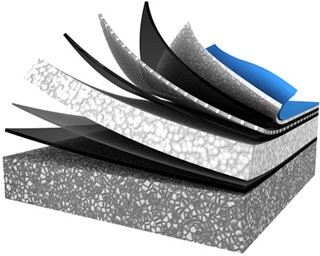By Kevin J. Collins, RPLU, Associate AIA

Architects are in a prime position to advise and provide solutions that are sustainable and focus on environmental needs. Find out the best way to approach drafting the contract for professional services and the provisions that should be included. Employing strong risk management practices will drive the future success of these projects.
Identify exposure potential related to underperformance
The increasing emphasis on sustainability and high-performance buildings presents both growing opportunities for design professionals and emerging risks that need to be managed. The use of green design criteria can minimize hazardous environmental consequences and reduce energy and water use. Perhaps most appealing to clients, life-cycle costs can be reduced, and the market value of the project may increase. Unfortunately, the exposure of firms to claims related to the underperformance of facilities they have designed may also increase if not managed effectively.

No matter how skilled and knowledgeable design professionals may be, there are some exposures that remain beyond their control. Clients, lenders, and brokers, as well as end-users (tenants, residents) tend to develop unrealistic expectations of how a building should perform and whether it will receive certification as a green project. Some of the factors affecting a building's performance include:

- Manufacturers and suppliers of new materials and technologies may misrepresent or overstate the performance of their products.
- Certification programs simply cannot be managed by firms since many of the code and regulatory restraints associated with green building practices extend beyond design services.
- Performance gains and energy and water savings associated with green design rely upon very low tolerances for construction defects or laxity in the operation and maintenance of building systems. Nearly all construction and operational deficiencies are beyond a design firm's control.
Responding to such risks takes more than just design skills. As the expectation but most importantly, the standard of care, evolves, clients will expect a higher level of services. As the value of green projects increases because of financial benefits, clients will demand contractual assurances that they will realize a commensurate return on their investment in a high-performance design. As the measurement of performance increases, clients will look more closely at the differences between design requirements and the actual use of energy, water, and other operational measurements.
Managing green design risks through contract language
The most important factor in preventing claims based on the underperformance of a sustainable design is that all parties involved understand, and acknowledge in writing, the inherent risks with such a project, the factors that make the outcome unpredictable, and the limits and responsibilities of each stakeholder to manage risks.
Establishing reasonable expectations at the beginning of the project is vital. One way to avoid unreasonable contractual provisions and unrealistic expectations is by informing the client that design services are recommendations that the client has to understand and, once satisfied, accept.

When drafting the contract for professional services, provisions should be included that limit the design professional's risk, or, at a minimum, express the client's acknowledgement that not all attributes of a sustainability program are within the design firm's control. Contractual provisions such as disclaimers and other exculpatory language need to be worded carefully, and should be drafted with the assistance of local legal counsel. This is especially true when the provisions include any waiver of claims, requirements for a legal defense, or the indemnification of costs.
It is essential to avoid language or actions that could be construed to establish a warranty of service or results. At the same time, including contractual provisions that are clear on the role of the design firm is critical. The following are two examples of contractual communication tools that can lead to a client's "informed consent."
When client wants the design to meet specific sustainability criteria
Client has made Design Firm aware that Client wants a specific level of sustainability incorporated into this Project and that Design Firm shall use the standards published by specific design guidelines or certification standard for this Project. Design Firm shall research the applicable sustainability requirements and design the Project with the intention of having the Project meet the requirements. Client recognizes that a project designed to meet a specific sustainability standard might not perform as designed because of the construction, operation, and maintenance of the Project and therefore agrees that it shall bring no claim against Design Firm if the project does not perform as intended, unless the negligence of the Design Firm is the sole cause of the performance deficiency.
Client also recognizes that during the design of the Project, Design Firm shall use professional judgment in the selection of materials, products, and systems for the Project, but that Design Firm cannot and does not warrant the performance of any specified material, product, or system. Design Firm will identify for Client any material, product, or system that, in the Design Firm's judgment based on examination of available performance information, might provide Client with a benefit on this Project, but does not have adequate information on its performance in actual construction or operation. Client acknowledges that it shall look solely to the manufacturer, supplier, or installer of materials, products, or systems if performance does not meet expectations.
When client wants third-party certification of sustainability
Client has made Design Firm aware that Client intends to pursue specific certification standard for this Project. Design Firm shall research the applicable certification requirements, design the Project with the intention of having the Project meet the requirements, and document the design of the Project for submission by the Client to the certifying organization. Client recognizes that certification is not based on design alone, but also on the construction, operation, and maintenance of the Project and therefore agrees that it shall bring no claim against Design Firm if the project is not certified as intended, unless the negligence of the Design Firm is the sole cause of the Project not being certified.
Client also recognizes that during the design of the Project, Design Firm shall use professional judgment in the selection of materials, products, and systems for the Project with the goal of meeting certification criteria, but that Design Firm cannot and does not warrant the performance of any specified material, product, or system. Design Firm will identify for Client any material, product, or system that, in the Design Firm's judgment based on examination of available performance information, might provide Client with a benefit on this Project, but does not have adequate information on its performance in actual construction or operation. Client acknowledges that it shall look solely to the manufacturer, supplier, or installer of materials, products, or systems if performance does not meet expectations.
Conclusion
The need for projects that are sustainable and are focused on the broader need of the environment will continue to be an area of in need of solutions and development. Architects are in a prime position to advise and provide solutions. A continued focus on strong risk management practices to properly balance the unique risks presented on these projects will also drive the future success of these projects.
_____________________________________
Victor O. Schinnerer & Company, Inc. and CNA work with the AIA Trust to offer AIA members quality risk management coverage through the AIA Trust Professional Liability Insurance Program, Business Owners Program, and Cyber Liability Insurance program to address the challenges that architects face today and in the future. Detailed information about both these programs may be found on the AIA Trust website, TheAIATrust.com.
Kevin J. Collins, RPLU, Associate AIA, is a Senior Vice President with Victor O. Schinnerer & Company, Inc. and a senior leader of the firm's Construction Industry Group. He has been with the firm for over 26 years in many capacities including: claims management, underwriting and risk management.
Mr. Collins has more than 25 years of experience working with design firms and other construction-related professional service firms on issues of professional liability exposure and business risks. He has spoken extensively on challenges to the design profession and a wide array of practice management issues. Kevin is the Schinnerer liaison to The AIA Trust. Mr. Collins is a graduate of the College of William & Mary in Williamsburg, Virginia where he received a B.A. in Government. He is also a member of the society of Registered Professional Liability Underwriters. Kevin may be reached at Kevin.J.Collins@Schinnerer.com or (301) 951-5412.
Letter from the Editor + Resources >
#2: Designing Net Zero Ready Buildings on a budget >
#3: The Race to 2030 >